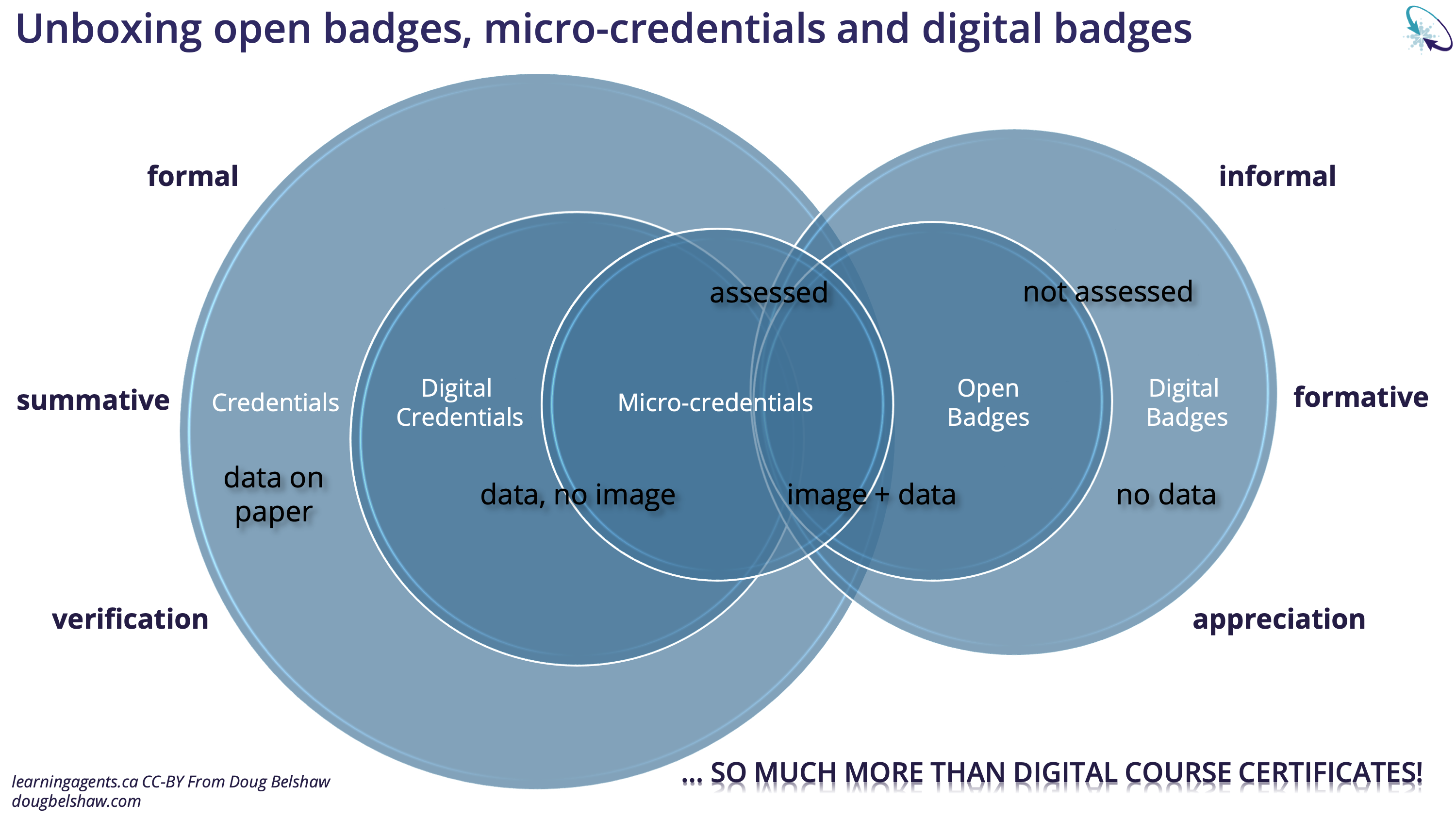1
What is an Open Badge?
What is an Open Badge?
Sobre
Futurologists were talking that future of recognition will be much more owned and managed by learners. There will be recognition for even a tiny but important experience gained throughout one's entire life, and it will help paint a better picture of every person.
Actually, the future has arrived! Open badges can do just that! You can create an open badge for the experience that matters and offer anyone to earn it. Open digital badges is an online standard to recognise learning and achievements. Compared to other traditional credentials, such as certificates, diplomas or degrees, open digital badges introduce new characteristics.
A digital badge can be earned for participation, for learning, for certain behaviour or for common work in a team.
Watch this video to learn the basics of Open Badges.
Since 2011, a wide variety of organisations have been using digital open badges across the globe – from NGOs to schools, universities, businesses and institutions. They contribute to better visibility of competencies acquired through a range of educational programmes. Badges lead to new learning pathways, career opportunities or academic degrees.
Open badges contribute to better self-knowledge and understanding of one’s own qualities and achievements. Badge earners can look back and view their past accomplishments as well as further pathways of learning. There is an increasing number of tools providing opportunities to manage and share digital credentials in a meaningful way.
Every open badge shows the issuer and can have links to specific competence frameworks. Open digital badges are easy to share anywhere on the web. Badge earners can share their achievements on social and professional networks, blogs and e-portfolios or simply add badge links to their CV. It gives great visibility to programmes and organisations issuing badges.
Cool things about Open Badges
You can dive deeper into the potential and meaning of badges for today's learning and education in the publication "What counts as learning" issued by the Connected Learning Alliance, written by Sheryl Grant. You can download the publication by clicking on this link: WhatCountsAsLearning_Grant.pdf.
Flexible
Open digital badges can be used in a variety of learning and working contexts, both online and offline, to motivate, recognise and verify any type of achievements.
Granular
Open digital badges act as micro-credentials. They visualise learning paths, show progress, specify achievements. Badges can be organised in groups according to categories.
Evidence-based
Open digital badges have a possibility to embed any type of evidence to verify learning and achievements claimed by the badge earner. Badge evidence enables ePortfolio solutions.
Verified
Open digital badges may include self-assessment, peer review or issuer assessment options. Badge issuer decides on the type of assessment to verify badge achievement and evidence.
Sharable
Open digital badges are easy to share anywhere on the web. Badge earners can share their achievements on social networks, blogs, ePortfolios and add badge links to CV.
Transferable
Open digital badges can be downloaded and imported to other platforms that uses the same Open Badges technical standard. Badge metadata is automatically loaded and displayed.
What are the differences between Open Badges, digital badges, and micro-credentials?
The image below by Don Present, based on an original by Doug Belshaw, gives a good overview of the landscape. Not all badges are credentials, and not all credentials are badges. Crucially, badges which align with the Open Badges standard contain metadata and have all of the advantages listed in the previous section.

Source: https://badge.wiki/wiki/What_Are_Open_Badges%3F , Don Presant, Learningagents.ca (based on an original by Doug Belshaw)
Resources
Course content is under the CC BY 4.0 Creative commons licence.


Funded by the European Union. Views and opinions expressed are however those of the author(s) only and do not necessarily reflect those of the European Commission. European Commission can not be held responsible for them.
Get activity badge
Open Badge Essentials Get this badge
This badge shows my understanding of essential aspects of digital Open Badges.
To earn this badge, I had to provide a personal reflection and ideas on one of the following:
- Skills that I possess, but don’t have recognition for.
- Skills that other people learn in our programme, but don't get recognition for.
I have a few ideas about what I would like to earn an open badge for and/or what kind of badges I would like to give to participants in our programmes.
This badge is issued as a part of the online course leading to the achievement of the Badge Quality Label.
Você precisa concluir 1 tarefa para receber a patente
Tarefas
Task no.1
Evidence verified by: one activity organiser
Reflect on what skills you possess that you don’t have recognition for (cooking, building, teaching, using some technology, whatever!). Imagine you have the power to issue an Open badge for yourself - what would the badge be for?
Write it down here, there is no right or wrong answer - it’s about your personal reflection.
The badge will be issued after one of the course facilitators approves the evidence.
Task no.2
Evidence verified by: one activity organiser
Think of the skills that other people learn and develop in your programmes and activities, and yet don’t get recognition for (cooking, building, teaching, using some technology, whatever!). Imagine you have the power to issue an Open badge for them - what would the badge be for?
Write it down here, there is no right or wrong answer - it’s about your ideas.
The badge will be issued after one of the course facilitators approves the evidence.
Organizadores
Cities of Learning Network
Badge issuer recognized with
Alterar idioma:

